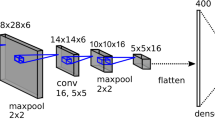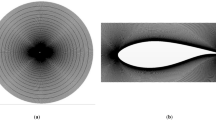Abstract
In this study, we propose an encoder–decoder convolutional neural network-based approach for estimating the pressure field around an airfoil. The developed tool is one of the early steps of a machine-learning-based aerodynamic performance prediction tool. Network training and evaluation are performed from a set of computational fluid dynamics (CFD)-based solutions of the 2-D flow field around a group of known airfoils involving symmetrical, cambered, thick and thin airfoils. Reynolds averaged Navier Stokes-based CFD simulations are performed at a selected single Mach number and for an angle of attack condition. The calculated pressure field, which is the main parameter for lift and drag calculations, is fed to the neural network training algorithm. Pressure data are calculated using CFD methods on high-quality structured computational grids. For the better shape learning, a distance map is generated from airfoil shape and provided to the algorithm at data locations of the pressure points relative to the airfoil shape. Experiments are conducted with unseen airfoil shapes to evaluate the predictive capability of our model. Performance analysis for airfoils with different thicknesses and cambers is conducted. We also investigated the effect of the shock on the performance of our model. Overall, our model achieves 88\(\%\) accuracy for unseen airfoil shapes and shows promise to capture the overall flow pattern accurately. Also, significant speed-up is achieved compared to time-consuming CFD simulations. We achieve almost four orders of speed-up with a much cheaper computational resource.













Similar content being viewed by others
References
Fielding JP (2017) Introduction to aircraft design, vol 11. Cambridge University Press, Cambridge
Milano M, Koumoutsakos P (2002) Neural network modeling for near wall turbulent flow. J Comput Phys 182(1):1
Zhang ZJ, Duraisamy K (2015) Machine learning methods for data-driven turbulence modeling. In: 22nd AIAA computational fluid dynamics conference, p 2460
Ling J, Kurzawski A, Templeton J (2016) Reynolds averaged turbulence modelling using deep neural networks with embedded invariance. J Fluid Mech 807:155
Zhu L, Zhang W, Kou J, Liu Y (2019) Machine learning methods for turbulence modeling in subsonic flows around airfoils. Phys Fluids 31(1):015105
Liu W, Fang J (2019) Iterative framework of machine-learning based turbulence modeling for Reynolds-averaged Navier–Stokes simulations. ar**v preprint ar**v:1910.01232
Maulik R, Sharma H, Patel S, Lusch B, Jennings E (2019) Accelerating RANS turbulence modeling using potential flow and machine learning. ar**v preprint ar**v:1910.10878
Yang C, Yang X, **ao X (2016) Data-driven projection method in fluid simulation. Comput Anim Virtual Worlds 27(3–4):415
Tompson J, Schlachter K, Sprechmann P, Perlin K (2017) Accelerating Eulerian fluid simulation with convolutional networks. In: Proceedings of the 34th international conference on machine learning, vol 70. JMLR. org, pp 3424–3433
Thirumalainambi R, Bardina J (2003) Training data requirement for a neural network to predict aerodynamic coefficients In: Independent component analyses, wavelets, and neural networks, vol 5102. International Society for Optics and Photonics, pp 92–103
Kurtulus DF (2009) Ability to forecast unsteady aerodynamic forces of flap** airfoils by artificial neural network. Neural Comput Appl 18(4):359
Ignatyev DI, Khrabrov AN (2015) Neural network modeling of unsteady aerodynamic characteristics at high angles of attack. Aerosp Sci Technol 41:106
Miyanawala TP, Jaiman RK (2017) An efficient deep learning technique for the Navier–Stokes equations: application to unsteady wake flow dynamics. ar**v preprint ar**v:1710.09099
Yilmaz E, German B (2017) A convolutional neural network approach to training predictors for airfoil performance. In: 18th AIAA/ISSMO multidisciplinary analysis and optimization conference, p 3660
Yuan Z, Wang Y, Qiu Y, Bai J, Chen G (2018) Aerodynamic coefficient prediction of airfoils with convolutional neural network. In: Asia-Pacific international symposium on aerospace technology. Springer, pp 34–46
Zhang Y, Sung WJ, Mavris DN (2018) Application of convolutional neural network to predict airfoil lift coefficient. In: AIAA/ASCE/AHS/ASC structures, structural dynamics, and materials conference, p 1903
Viquerat J, Hachem E (2019) A supervised neural network for drag prediction of arbitrary 2D shapes in low Reynolds number flows. ar**v preprint ar**v:1907.05090
Sun G, Sun Y, Wang S (2015) Artificial neural network based inverse design: airfoils and wings. Aerosp Sci Technol 42:415
Yilmaz E, German B (2018) A deep learning approach to an airfoil inverse design problem. In: 2018 multidisciplinary analysis and optimization conference, p 3420
Atalay KD, Dengiz B, Yavuz T, Koç E, İç YT (2020) Airfoil–slat arrangement model design for wind turbines in fuzzy environment. Neural Comput Appl 32:1–9
Guo X, Li W, Iorio F (2016) Convolutional neural networks for steady flow approximation. In: Proceedings of the 22nd ACM SIGKDD international conference on knowledge discovery and data mining. ACM, pp 481–490
Singh AP, Medida S, Duraisamy K (2017) Machine-learning-augmented predictive modeling of turbulent separated flows over airfoils. AIAA J 55:2215–2227
** X, Cheng P, Chen WL, Li H (2018) Prediction model of velocity field around circular cylinder over various Reynolds numbers by fusion convolutional neural networks based on pressure on the cylinder. Phys Fluids 30(4):047105
Fukami K, Fukagata K, Taira K (2019) Super-resolution reconstruction of turbulent flows with machine learning. J Fluid Mech 870:106
Wang R, Kashinath K, Mustafa M, Albert A, Yu R (2019) Towards physics-informed deep learning for turbulent flow prediction. ar**v preprint ar**v:1911.08655
Sekar V, Jiang Q, Shu C, Khoo BC (2019) Fast flow field prediction over airfoils using deep learning approach. Phys Fluids 31(5):057103
Kim B, Azevedo VC, Thuerey N, Kim T, Gross M, Solenthaler B (2019) Deep fluids: a generative network for parameterized fluid simulations. In: Computer graphics forum, vol 38. Wiley Online Library, pp 59–70
Chen J, Viquerat J, Hachem E (2019) U-net architectures for fast prediction of incompressible laminar flows. ar**v preprint ar**v:1910.13532
Lee S, You D (2019) Data-driven prediction of unsteady flow over a circular cylinder using deep learning. J Fluid Mech 879:217
Bhatnagar S, Afshar Y, Pan S, Duraisamy K, Kaushik S (2019) Prediction of aerodynamic flow fields using convolutional neural networks. Comput Mech 64(2):525
Thuerey N, Weißenow K, Prantl L, Hu X (2020) deep learning methods for Reynolds-averaged Navier–Stokes simulations of airfoil flows. AIAA J 58(1):25
Selig M (2016) UIUC airfoil coordinates database, vol 18. UIUC Applied Aerodynamics Group, Urbana
Spalart P, Allmaras S (1992) A one-equation turbulence model for aerodynamic flows. In: 30th aerospace sciences meeting and exhibit, p 439
Gregory N, O’reilly C (1970) Low-speed aerodynamic characteristics of NACA 0012 aerofoil section, including the effects of upper-surface roughness simulating hoar frost
Toro EF, Spruce M, Speares W (1994) Restoration of the contact surface in the HLL-Riemann solver. Shock Waves 4(1):25
Vinokur M (1983) On one-dimensional stretching functions for finite-difference calculations. J Comput Phys 50(2):215
Kingma DP, Ba J (2014) Adam: a method for stochastic optimization. ar**v preprint ar**v:1412.6980
Paszke A, Gross S, Massa F, Lerer A, Bradbury J, Chanan G, Killeen T, Lin Z, Gimelshein N, Antiga L et al (2019) PyTorch: an imperative style, high-performance deep learning library. In: Advances in neural information processing systems, pp 8024–8035
Author information
Authors and Affiliations
Corresponding author
Ethics declarations
Conflict of interest
The authors declare that they have no conflict of interest.
Additional information
Publisher's Note
Springer Nature remains neutral with regard to jurisdictional claims in published maps and institutional affiliations.
Rights and permissions
About this article
Cite this article
Duru, C., Alemdar, H. & Baran, Ö.U. CNNFOIL: convolutional encoder decoder modeling for pressure fields around airfoils. Neural Comput & Applic 33, 6835–6849 (2021). https://doi.org/10.1007/s00521-020-05461-x
Received:
Accepted:
Published:
Issue Date:
DOI: https://doi.org/10.1007/s00521-020-05461-x




